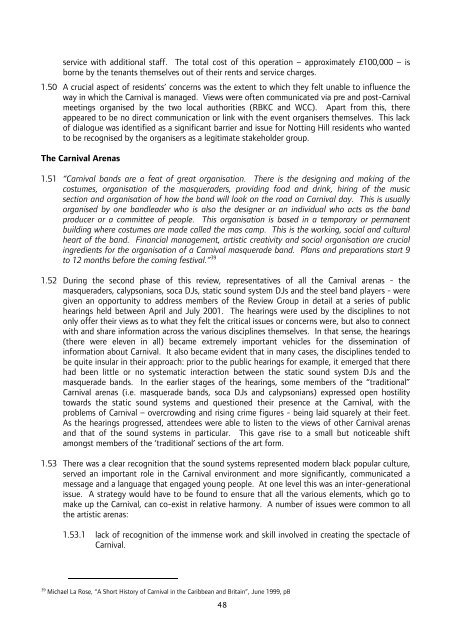Notting Hill Carnival Strategic Review - Intelligent Space
Notting Hill Carnival Strategic Review - Intelligent Space
Notting Hill Carnival Strategic Review - Intelligent Space
You also want an ePaper? Increase the reach of your titles
YUMPU automatically turns print PDFs into web optimized ePapers that Google loves.
service with additional staff. The total cost of this operation – approximately £100,000 – is<br />
borne by the tenants themselves out of their rents and service charges.<br />
1.50 A crucial aspect of residents’ concerns was the extent to which they felt unable to influence the<br />
way in which the <strong>Carnival</strong> is managed. Views were often communicated via pre and post-<strong>Carnival</strong><br />
meetings organised by the two local authorities (RBKC and WCC). Apart from this, there<br />
appeared to be no direct communication or link with the event organisers themselves. This lack<br />
of dialogue was identified as a significant barrier and issue for <strong>Notting</strong> <strong>Hill</strong> residents who wanted<br />
to be recognised by the organisers as a legitimate stakeholder group.<br />
The <strong>Carnival</strong> Arenas<br />
1.51 “<strong>Carnival</strong> bands are a feat of great organisation. There is the designing and making of the<br />
costumes, organisation of the masqueraders, providing food and drink, hiring of the music<br />
section and organisation of how the band will look on the road on <strong>Carnival</strong> day. This is usually<br />
organised by one bandleader who is also the designer or an individual who acts as the band<br />
producer or a committee of people. This organisation is based in a temporary or permanent<br />
building where costumes are made called the mas camp. This is the working, social and cultural<br />
heart of the band. Financial management, artistic creativity and social organisation are crucial<br />
ingredients for the organisation of a <strong>Carnival</strong> masquerade band. Plans and preparations start 9<br />
to 12 months before the coming festival.” 39<br />
1.52 During the second phase of this review, representatives of all the <strong>Carnival</strong> arenas - the<br />
masqueraders, calypsonians, soca DJs, static sound system DJs and the steel band players - were<br />
given an opportunity to address members of the <strong>Review</strong> Group in detail at a series of public<br />
hearings held between April and July 2001. The hearings were used by the disciplines to not<br />
only offer their views as to what they felt the critical issues or concerns were, but also to connect<br />
with and share information across the various disciplines themselves. In that sense, the hearings<br />
(there were eleven in all) became extremely important vehicles for the dissemination of<br />
information about <strong>Carnival</strong>. It also became evident that in many cases, the disciplines tended to<br />
be quite insular in their approach: prior to the public hearings for example, it emerged that there<br />
had been little or no systematic interaction between the static sound system DJs and the<br />
masquerade bands. In the earlier stages of the hearings, some members of the “traditional”<br />
<strong>Carnival</strong> arenas (i.e. masquerade bands, soca DJs and calypsonians) expressed open hostility<br />
towards the static sound systems and questioned their presence at the <strong>Carnival</strong>, with the<br />
problems of <strong>Carnival</strong> – overcrowding and rising crime figures - being laid squarely at their feet.<br />
As the hearings progressed, attendees were able to listen to the views of other <strong>Carnival</strong> arenas<br />
and that of the sound systems in particular. This gave rise to a small but noticeable shift<br />
amongst members of the ‘traditional’ sections of the art form.<br />
1.53 There was a clear recognition that the sound systems represented modern black popular culture,<br />
served an important role in the <strong>Carnival</strong> environment and more significantly, communicated a<br />
message and a language that engaged young people. At one level this was an inter-generational<br />
issue. A strategy would have to be found to ensure that all the various elements, which go to<br />
make up the <strong>Carnival</strong>, can co-exist in relative harmony. A number of issues were common to all<br />
the artistic arenas:<br />
1.53.1 lack of recognition of the immense work and skill involved in creating the spectacle of<br />
<strong>Carnival</strong>.<br />
39<br />
Michael La Rose, “A Short History of <strong>Carnival</strong> in the Caribbean and Britain”, June 1999, p8<br />
48








